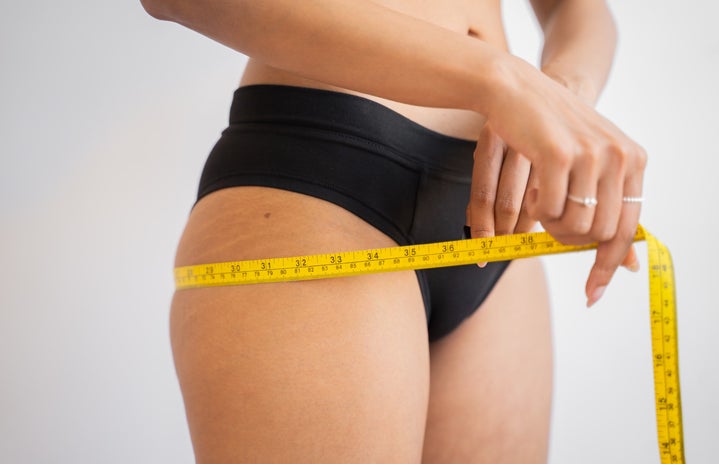It’s hard to tell when exactly the fashion industry stepped away from the effort towards inclusivity and returned to the heroin chic mindset, but its resurgence is clear through the rising animosity surrounding plus-size individuals from many online. First popularized by Kate Moss, “heroin chic,” coined as a reference to the popularity of heroin throughout the modeling industry at the time, quickly caught on when both “the fashion industry and media put her body on a pedestal,” and represented the favored style of the ’90s through the early 2000s. At the time of its popularity, heroin chic was distinguished by “pale skin, a very thin frame, dark under-eye circles, androgynous clothing, and limp or stringy hair.” Alternatively, in recent years, people have used the term not in relation to a specific fashion trend, but instead to describe the skinny, ideal body. This shift is harmful to everyone, even those outside of the fashion world. Researchers fear that the return of heroin chic will go past eating disorders and into actual drug use. Fatphobia, defined as the “implicit bias of overweight individuals,” is nothing new in the fashion world, but it did subside for a brief period of time after it was at an all-time high in the 90s and 2000s. However, over the past couple of years, people have once again begun vocalizing their dislike of the inclusion of plus-size bodies in the fashion world, whether it be through news articles or social media apps. With this resurgence, we are seeing a drastic uptick in celebrities and influencers changing their bodies to fit the new beauty standard.
In a video that recently went viral, TikTok user Ro Mitchell addresses the recent increase in promoting “excessive weight loss…if not underweight bodies” on TikTok. She emphasizes that the so-called “influencer bodies” aren’t always obtained through regular diets and workout routines like influencers seem to advertise. According to Mitchell, many of these bodies are unattainable without extreme diets or medical intervention, such as weight loss drugs or surgery. Despite this, they are still being idolized and becoming the cultural norm. These influencers are inadvertently (and sometimes advertently) contributing to the online eating disorder culture. One of the first and more infamous instances of these eating disorder cultures in an online space was Tumblr in 2012, where the issue became so prevalent that the company had to put restrictions on content that promotes eating disorders. Another example of social media stepping away from inclusivity and bringing back fatphobic rhetoric is the resurgence of body checking, where people on social media show “how little they eat or how long and intense their workouts are.” in fact they have added to it by posting videos of their bodies to show how thin they are, further contributing to this toxic culture.
Similarly, “Being Skinny is the Outfit” is a recent trend where people post themselves wearing a plain outfit and caption it with an insensitive phrase along the lines of “wearing something basic, [because] being skinny is the outfit.” This content is harmful to those viewing it because it sends the message that the most important thing about them is their body shape and what size they wear. This also has a negative impact on the fashion world because it strips away the creativity that was previously required to be a fashion influencer or just part of the fashion community in general.
The reactions towards Ashley Graham walking in the Victoria’s Secret Fashion Show is another example of the harmful expectations that come with the return of heroin chic. Graham’s announcement that she will walk in the Victoria’s Secret Fashion Show garnered a lot of attention, both positive and negative. Some of these reactions can be seen in the comment section of the TikTok where she made her announcement. In the video, Graham stated that the brand “is starting to do things right” by including plus sizes in their new line; however, many expressed their disagreement with the brand’s choice with the argument that fashion should be reserved for those with thin bodies. One user said, “Did they not understand the assignment??” and another simply responded, “No no no.” Others have made less direct comments, instead remarking on Graham’s walking, saying they want the “old angels back,” “VS should have hired real supermodels,” or that her outfit looked “cheap.”
Achieving the perfect ’90s or 2000s look is not worth sacrificing a person’s physical and mental health and well-being. The fashion community needs to step away from heroin chic and back towards inclusivity before the 2000s fatphobia and eating disorder epidemic makes its return.


